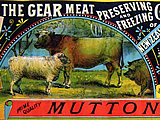What happened that day?
See historic events for any day of the year by entering the date below. Why not try your birthday?
Kiwi of the Week
Today in History

1882 First shipment of frozen meat leaves NZ
The success of the Dunedin's first shipment of frozen meat to Britain in 1882 helped to lift New Zealand out of the economic depression of the 1880s. This voyage from Port Chalmers to London paved the way for the trade in frozen meat and dairy products that was to become the cornerstone of the New Zealand's 20th-century economy. The production of lamb, butter and cheese would flourish as New Zealand established itself as 'Britain's farmyard'.
The Dunedin's voyage was organised by William Soltau Davidson, general manager of the giant New Zealand and Australian Land Company, and the company's local manager, Thomas Brydone. Since the mid 1870s frozen meat had been successfully shipped to Europe from Argentina and Australia, but to do so from New Zealand demanded an even longer voyage.
Brydone built an export slaughterhouse at Totara Estate, near Oamaru, from where 95% of the first cargo would originate. The carcasses were transported by horse and cart to Oamaru then by steam train (in ice boxes) to Port Chalmers, where they were frozen by a steam-powered Bell-Coleman freezing plant installed aboard the sailing ship Dunedin. But after 600 carcasses had been frozen the plant failed, forcing the sale or disposal of the original cargo. Undeterred, Brydone had the plant fixed, and a further 5000 carcasses were frozen aboard the ship over two months.
The Dunedin sailed on 15 February, but when it became becalmed in the tropics, the crew noticed that the cold air in the hold was not circulating properly. To save the historic cargo, Captain Whitson crawled inside and sawed extra air holes, almost freezing to death in the process; crew members had to pull him out by a rope attached to his ankles and resuscitate him. When the Dunedin arrived in London after three months at sea, it was found that every carcass – except one – was in superb condition.
Image: Gear Meat Company label (Te Ara)
Internal links

1978 New Zealand beats England in a cricket test for the first time
New Zealand had suffered many defeats at the hands of English cricketers before finally winning its first test at Wellington's Basin Reserve in February 1978.
Prior to England's tour to New Zealand in 2008 the two countries had met in 88 tests, with England winning 41. New Zealand has won only seven, with the remainder being drawn. Official cricketing contact with England began when the Marylebone Cricket Club (MCC) sent a team to New Zealand in the 1906–07 season. Founded in 1787, the MCC is a private members' club based at Lord's in London. It was the original governing body of cricket in England, and organised that country's national teams for the first three-quarters of the 20th century.
Games against the MCC were regarded as unofficial tests, and visits here usually occurred at the end of the more important Ashes tours of Australia. A New Zealand team first went to England in 1927. On this visit no tests were played – New Zealand was not considered good enough – and 12 of the 38 games were second-class fixtures. After New Zealand was granted test status in the 1929–30 season, it played England in 19 of its first 22 tests over the following 21 years.
The lowest innings total ever made in a test match is unfortunately New Zealand's record. The paltry total of 26 runs scored against the 1955 English tourists at Eden Park perhaps confirmed why the MCC was reluctant to give New Zealand full test status.
Revenge was a long time coming, but for long-suffering New Zealand cricket fans the 1978 victory was certainly sweet. Needing only 137 to win in their second innings, the English slumped to be all out for just 64. Richard Hadlee captured 6 wickets for 26 runs and went on to become New Zealand's greatest wicket-taker in test history.
This first victory against England – at the 48th attempt – was a tribute to perseverance, and it was enthusiastically welcomed as proof that New Zealand could at last compete with our former colonial masters and inventors of the game. The three-match series was drawn 1–1.














